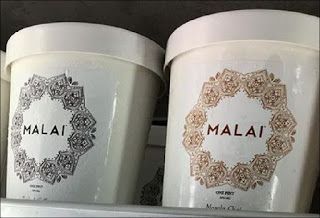Finding that relevant consumers would understand the term MALAI to refer to a key aspect of "ice cream, gelato, dairy-free ice cream, frozen yogurt, frozen desserts, ice cream sandwiches, sorbet, freezer pops, and ice cream sundaes," the Board affirmed a refusal to register on the ground of genericness. In re Twenty-Two Desserts, LLC, Serial No. 86586833 (August 6, 2019) [precedential] (Opinion by Judge Frances Wolfson).

The Board applied its standard two-part test for determining whether a term is generic: (1) what is the genus (class or category) of the goods or services at issue; and (2) does the relevant public understand the term primarily to refer to that genus. Princeton Vanguard, 114 USPQ2d at 1830 (citing Marvin Ginn, 228 USPQ at 530); Couch/Braunsdorf Affinity, Inc. v. 12 Interactive, LLC, 110 USPQ2d 1458, 1462 (TTAB 2014). "Any term that the relevant public uses or understands to refer to the genus of goods, or a key aspect or subcategory of the genus, is generic." Citing Royal Crown Co., Inc. v. The Coca-Cola Co., 127 USPQ2d 1041, 1046-1047 (Fed. Cir. 2018); In re Cordua Rests., Inc., 118 USPQ2d 1632, 1638 (Fed. Cir. 2016). The USPTO must present "clear evidence" of genericness to support such a refusal. See In re Hotels.com, 91 USPQ2d 1252, 1253 (Fed. Cir. 2009); Cordua, 118 USPQ2d at 1533.
There was no dispute that applicant's identification of goods adequately defines the genus at issue. The relevant consuming public comprises ordinary consumers who purchase and eat ice cream products. The question, then, was how does the relevant public perceive the term MALAI in the context of applicant's goods?
Examining Attorney Jason Paul Blair relied on a dictionary definition of "malai" (an Indian cooking ingredient) and a Wikipedia entry for "Ras Malai" as a type of dessert, in maintaining that that the word MALAI "is commonly used in the English language as a genus of rich, high-fat creams commonly used in Indian and South Asian culinary dishes, especially dishes with a sweet taste." He also submitted articles, recipes, and material from several Internet sources that identify "malai" as a cream.
The Board agreed with the examining attorney that the record evidence showed that "'malai' has an independent meaning in English for a specific cooking ingredient, cream." Moreover, "malai" has been used to identify a creamy food principally made from malai, including items that fall within - i.e., are a sub-group or type of - the goods broadly identified in the subject application: for example, "malai kulfi," a type of Indian ice cream.
Applicant argued that the doctrine of foreign equivalents should not be applied to the term MALAI because consumers would not stop and translate it, but the Board pointed out that the examining attorney did not rely on that doctrine, but rather on evidence that the word "malai" itself has a meaning in English that is relevant to the goods at issue. See, for example, Cordua, 118 USPQ2d at 1537 (noting that the USPTO found that "churrasco" is used in English to refer to grilled meat).
Applicant also contended that the primary meaning of "malai" is "the best of choicest part of a thing - i.e., the cream of the crop." The Board, however, saw nothing in the record to support the contention that consumers will apply that meaning to "malai" with regard to the goods at issue. Moreover, because applicant was seeking registration on the Supplemental Register, it conceded that that the term is merely descriptive of the goods, and therefore "arguments regarding other meanings for [MALAI] and double entendre are inapplicable." In re Rosemount Inc., 86 USPQ2d 1436, 1439 (TTAB 2008).
Finally, applicant argued that a generic name of an ingredient is not necessarily generic for a product containing that ingredient. The Board agreed that there is no per se rule that the name of any ingredient in a product will necessarily be generic; but where, as here, the public understands the ingredient name "to refer to a key aspect or category of the genus of the goods, it is generic for those goods." See Royal Crown, 127 USPQ2d at 1046; see also In re Empire Tech. Dev. LLC, 123 USPQ2d 1544 (TTAB 2017) (COFFEE FLOUR generic for flour made from coffee berries); In re Demos, 172 USPQ 408, 409 (TTAB 1971) ("CHAMPAGNE" merely names principal ingredient of applicant's salad dressing and is unregistrable); In re Hask Toiletries, Inc., 223 USPQ 1254 (TTAB 1984) (HENNA 'N' PLACENTA generic for hair conditioner because "henna" and "placenta" refer to the two key ingredients of the product and the combination created no new significance).
The Board therefore affirmed the refusal to register on the Supplemental Register under Section 23 of the Lanham Act.
The content of this article is intended to provide a general guide to the subject matter. Specialist advice should be sought about your specific circumstances.
